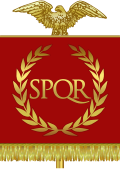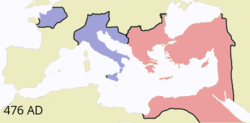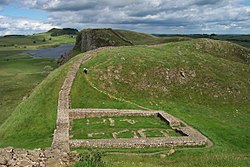Roman Empire
The Roman Empire was the largest empire of the ancient world.[n 8] Its capital was Rome. The Empire was round the Mediterranean area.
Roman Empire
| |||||||||||
|---|---|---|---|---|---|---|---|---|---|---|---|
| 27 BC – 395 AD (unified)[1][2] 395 AD – 476/480 AD (Western) 395 AD – 1453 AD (Eastern) | |||||||||||
![The Roman Empire at its greatest extent, 117 AD, the time of Trajan's death (with its vassals in pink).[3]](https://upload.wikimedia.org/wikipedia/commons/thumb/0/00/Roman_Empire_Trajan_117AD.png/500px-Roman_Empire_Trajan_117AD.png) | |||||||||||
| Capital |
| ||||||||||
| Common languages |
| ||||||||||
| Religion |
| ||||||||||
| Demonym(s) | Roman | ||||||||||
| Government | Semi-elective, functionally absolute monarchy | ||||||||||
| Some Emperors | |||||||||||
• 27 BC – 14 AD | Augustus (first) | ||||||||||
• 98 AD – 117 AD | Trajan | ||||||||||
• 270 AD – 275 AD | Aurelian | ||||||||||
• 284 AD – 305 AD | Diocletian | ||||||||||
• 306 AD – 337 AD | Constantine I | ||||||||||
• 379 AD – 395 AD | Theodosius I[n 3] | ||||||||||
• 474 AD – 480 AD | Julius Nepos[n 4] | ||||||||||
• 475 AD – 476 AD | Romulus Augustus | ||||||||||
• 527 AD – 565 AD | Justinian I | ||||||||||
• 780 AD – 797 AD | Constantine VI[n 5] | ||||||||||
• 976 AD – 1025 AD | Basil II | ||||||||||
• 1449 AD – 1453 AD | Constantine XI[n 6] | ||||||||||
| Legislature | Senate | ||||||||||
| Historical era | Classical era to Late Middle Ages | ||||||||||
| 32 BC – 30 BC | |||||||||||
• | 30 BC – 2 BC | ||||||||||
• Constantinople becomes capital | 11 May 330 AD | ||||||||||
| 17 January 395 AD | |||||||||||
| 4 September 476 AD | |||||||||||
• Murder of Emperor Julius Nepos | 25 April 480 AD | ||||||||||
| 12 April 1204 | |||||||||||
• Reconquest of Constantinople | 25 July 1261 | ||||||||||
• | 29 May 1453 | ||||||||||
• Fall of Trebizond | 15 August 1461 | ||||||||||
| Area | |||||||||||
| 25 BC[4][5] | 2,750,000 km2 (1,060,000 sq mi) | ||||||||||
| 117 AD[4][6][7] | 5,000,000–6,500,000 km2 (1,900,000–2,500,000 sq mi) | ||||||||||
| 390 AD[4] | 4,400,000 km2 (1,700,000 sq mi) | ||||||||||
| Population | |||||||||||
| 56,800,000 | |||||||||||
| Currency | Sestertius,[n 7] Aureus, Solidus, Nomisma | ||||||||||
| |||||||||||
The Empire started in 27 BC, when Octavian became Emperor Augustus after death of Julius Caesar. The fall of Western Roman Empire to the Germanic kings in 476 AD, marked the end of classical antiquity and the beginning of the Middle Ages.[8]
The Empire was the third stage of Ancient Rome. Rome was first ruled by Roman kings, later by the Roman Republic and then by an emperor.
Many modern lands were once part of the Roman Empire such as Britain (not Scotland), Spain, Portugal, France, Italy, Greece, Turkey, Germany, Egypt, Levant, Crimea, Switzerland and the northern coast of Africa. The main language of the Roman Empire was Latin, with Greek as an important secondary language, especially in the Eastern provinces.
The Western half of the Roman Empire lasted for about 500 years until the barbarian general Odoacer defeated its final emperor, Romulus Augustus. On the other hand, the eastern half, consisting of the Balkans, Anatolia, The Levant and Egypt, continued for about 1000 more years. The Levant and Egypt were lost to the Arabs in the 8th century. The eastern part was the Eastern Roman Empire. Its capital was Constantinople, which is now called Istanbul.
Government
In order to control their large empire, the Romans developed ideas about law and government. They developed the best army in the world at the time and ruled by force. They had fine engineering and built roads, cities, and outstanding buildings. The Empire was divided into provinces, each with a governor plus civil and military support. Letters, both official and private, went constantly to and from Rome.
Trade was most important for Rome, a city of more than a million people (which was by far the largest city in the world). It needed and got wheat from Egypt, tin from Britannia, grapes from Gaul and so on. In return, the Romans built provincial capitals into fine cities, protected them from raids by barbarians. They gave education and career opportunities for young people in the provinces, such as jobs in the Roman army.
In principle, Emperors had absolute control and could do as they pleased. In practice, they faced some difficult problems. They had a staff of what would today be called "civil servants" and the advice of the Roman Senate. The emperor had to decide the most important issues facing the empire, and what should be done about them. Most tried to do two things. One was doing things to improve the life of Romans in peacetime. The other was fighting and defeating Rome's enemies, which the wealthy empire always had.
For Roman emperors the succession would often be an adopted son. The Emperor would notice an outstanding young man from one of the best families and would adopt him as his son. Before he died, he would make clear who he thought should succeed him. He could make his adopted son a Roman consul, or state in his will that the younger man should succeed him. Sometimes, that worked well. but not always. Every now and then, a civil war would be fought between claimants to the throne.
An adopted son or two gave the Emperor more choices. Some Emperors had no son, and others had sons who did not survive. Later on, Emperors grew so weak that the Roman army would just pick one of their generals to be the next Emperor, which sometimes led to civil war.
The Romans fought many wars against other countries and against barbarians several times. They enjoyed watching violent sports. They watched chariots races and fights between gladiators (men using weapons). Unlike in modern sports, the fighters were often killed in fights. Romans enjoyed those shows in the Colosseum.
The Romans had great civil engineering. They built many large public buildings and villas, aqueducts to carry water, stone bridges and roads. Some of those things can still be seen today. Many famous writers were Romans, including Cicero and Virgil.
The New Testament of the Bible tells about the Romans in the life of Jesus Christ. During Jesus' life, the Romans, who were pagans, ruled his country. Later, several emperors tried to destroy Christianity but did not succeed. By 312 AD, Emperor Galerius allowed people freedom to follow Christianity, and the next year, a general, Constantine, became Emperor and converted to Christianity.
The city of Rome was taken over several times by barbarians, notably in 410 AD when a barbarian tribe called the Goths sacked the city (looting). The last Western Roman emperor, Romulus Augustus, abdicated in 476 AD. The Roman Empire would last another 1000 years as the Byzantine Empire in the East.
The main coin of the Roman Empire was the silver denarius. Later denarii were smaller.
Various reasons have been given for the fall of Rome. Edward Gibbon wrote The Decline and Fall of the Roman Empire in which he investigated various ideas. Chief among them was, in his opinion, the effect of Christianity on the ability of the Empire to defend itself militarily.
Other historians blame the unstable system of leadership. In a later 50-year period, only two of 22 emperors died a natural death. Most of the other emperors were assassinated.[9]
Roman Empire Media
Animated overview of the Roman territorial history from the Republic until the fall of its last remnant (the Byzantine Empire) in 1453
The Barbarian invasions consisted of the movement of (mainly) ancient Germanic peoples into Roman territory. Historically, this event marked the transition between classical antiquity and the Middle Ages.
A segment of the ruins of Hadrian's Wall in northern England, overlooking Crag Lough
A multigenerational banquet depicted on a wall painting from Pompeii (1st century AD)
Dressing of a priestess or bride, Roman fresco from Herculaneum, Italy (30–40 AD)
References
- ↑ Morley, Neville (2010). The Roman Empire: Roots of Imperialism. Pluto Press. ISBN 978-0-7453-2870-6.
- ↑ Diamond, Jared (2011). Collapse: how societies choose to fail or succeed: revised edition. Penguin. p. 13. ISBN 978-1-101-50200-6.
- ↑ Bennett, Julian (1997). Trajan: Optimus Princeps : a life and times. Routledge. ISBN 978-0-415-16524-2.. Fig. 1. Regions east of the Euphrates river were held only in the years 116–117.
- ↑ 4.0 4.1 4.2 Taagepera, Rein (1979). "Size and Duration of Empires: Growth-Decline Curves, 600 B.C. to 600 A.D". Social Science History. Duke University Press. 3 (3/4): 125. doi:10.2307/1170959. ISSN 0145-5532. JSTOR 1170959.
- ↑ Durand, John D. (1977). "Historical estimates of world population: an evaluation". Population and Development Review. 3 (3): 253–296. doi:10.2307/1971891. JSTOR 1971891.
- ↑ Turchin, Peter; Adams, Jonathan M.; Hall, Thomas D (2006). "East-West orientation of historical empires" (PDF). Journal of World-systems Research. 12 (2): 222. ISSN 1076-156X. Archived from the original (PDF) on 17 May 2016. Retrieved 6 February 2016.
- ↑ Parker, Philip (2009). The Empire stops here: a journey along the frontiers of the Roman World. London: Pimlico. p. 2. ISBN 978-1-84595-003-3.
- ↑ Kelly, Christopher (2007). The Roman Empire: a very short introduction. Oxford University Press. ISBN 978-0-19-280391-7.
- ↑ Iorwerth Eiddon & others, ed. (2005). The Cambridge Ancient History: Volume 12, The Crisis of Empire, AD 193–337. Cambridge University Press. ISBN 978-0-521-30199-2.
- ↑ Other ways of referring to the "Roman Empire" among the Romans and Greeks themselves included Res publica Romana or Imperium Romanorum (also in Greek: Βασιλεία τῶν Ῥωμαίων – ["Dominion (Literally 'kingdom' but also interpreted as 'empire') of the Romans"]) and Romania. Res publica means Roman "commonwealth" and can refer to both the Republican and the Imperial eras. Imperium Romanum (or "Romanorum") refers to the territorial extent of Roman authority. Populus Romanus ("the Roman people") has often been used to indicate the Roman state in matters involving other nations. The term Romania, initially a colloquial term for the empire's territory as well as a collective name for its inhabitants, appears in Greek and Latin sources from the 4th century onward and was eventually carried over to the Eastern Roman Empire (see R.L. Wolff, "Romania: The Latin Empire of Constantinople" in Speculum 23 (1948), pp. 1–34 and especially pp. 2–3).
- ↑ Between 1204 and 1261, there was an interregnum during which the empire was divided into the Empire of Nicaea, the Empire of Trebizond and the Despotate of Epirus, all of which were contenders for rule of the empire. The Empire of Nicaea is considered the legitimate continuation of the Roman Empire because it managed to retake Constantinople.
- ↑ The final emperor to rule over all of the Roman Empire's territories before its conversion to a diarchy.
- ↑ Officially the final emperor of the Western empire.
- ↑ Final ruler to be universally recognized as Roman Emperor, including by the papacy and the Western European powers.
- ↑ Last emperor of the Eastern (Byzantine) empire.
- ↑ Abbreviated "HS". Prices and values are usually expressed in sesterces; see #Currency and banking for currency denominations by period.
- ↑ Latin: [Imperium Rōmānum] Error: {{Lang}}: text has italic markup (help), Classical Latin: [ɪmˈpɛ.ri.ũː roːˈmaː.nũː]; Koine and Medieval Greek: Βασιλεία τῶν Ῥωμαίων, tr. <span title="Lua error in package.lua at line 80: module 'Module:Language/data/ISO 639-2' not found. transliteration" class="Unicode" style="white-space:normal; text-decoration: none">Basileia tōn Rhōmaiōn
Other websites
| Wikimedia Commons has media related to Lua error in Module:Commons_link at line 62: attempt to index field 'wikibase' (a nil value).. |
- An old map of the Roman Empire in 400 AD
- BBC, Romans for Children Archived 2009-04-24 at the Wayback Machine, website on ancient Rome for children at the level of primary school
- Rome Unleashed Archived 2014-03-28 at the Wayback Machine, interactive educational website on ancient Rome for students








